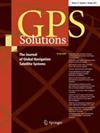仅伽利略和多gnss PPP解决方案中接收机时钟参数的随机建模
IF 3.9
1区 地球科学
Q1 REMOTE SENSING
引用次数: 1
摘要
摘要在精确点定位(PPP)中,接收机时钟参数在每个观测历元中通常是独立估计的,这使得估计的台站坐标和对流层参数由于相关性而增加了噪声。将随机模型应用于接收机时钟参数稳定PPP解决方案,并减少时间传输的时钟噪声。然而,接收机时钟建模仅适用于连接到最稳定原子钟的GNSS接收机。我们提出了接收机时钟建模,该建模涉及随机游走形式的马尔可夫随机过程。我们在运动和静态PPP中测试了配备不同类型时钟的GNSS站的不同水平的随机漫步约束,分别用于Galileo-only和multi-GNSS解决方案。在多gnss解决方案中,公共时钟参数是由系统间偏差(ISBs)导出的。这就提出了应该只对公共时钟施加约束还是也对isb施加约束的问题。我们发现,通过对公共时钟参数施加约束并将ISB估计为恒定参数,以及以1:100的比例约束公共时钟参数和ISB,可以获得类似的结果。时钟与isb约束的其他比率,如1:1和1:10,给出的结果较差。在运动PPP中,随机时钟建模对北坐标和东坐标分量的影响很小,而对于配备氢脉泽的GNSS接收机,向上分量的影响很大。在静态PPP中,由于时钟的噪声降低,时钟建模改善了时间传输。本文章由计算机程序翻译,如有差异,请以英文原文为准。
Stochastic modeling of the receiver clock parameter in Galileo-only and multi-GNSS PPP solutions
Abstract In Precise Point Positioning (PPP), the receiver clock parameter is typically estimated independently in each observation epoch, which increases the noise of the estimated station coordinates and troposphere parameters due to correlations. Applying stochastic modeling to the receiver clock parameter stabilizes PPP solutions and reduces clock noise for the time transfer. However, the receiver clock modeling is possible only for the GNSS receivers connected to the utmost stable atomic clocks. We propose receiver clock modeling that involves the Markov stochastic process in the form of a random walk. We test different levels of random walk constraints for GNSS stations equipped with different types of clocks for Galileo-only and multi-GNSS solutions in kinematic and static PPP. In multi-GNSS solutions, the common clock parameter is derived with inter-system biases (ISBs). This raises the question of the constraints that should be imposed on the common clock only or also on the ISBs. We found that similar results can be achieved by imposing constraints on the common clock parameter and estimating ISB as a constant parameter and when constraining the common clock parameter and ISBs with a ratio of 1:100. Other ratios of clock-to-ISB constraints, such as 1:1 and 1:10, give inferior results. In the kinematic PPP, stochastic clock modeling has a marginal impact on the North and East coordinate components, whereas the Up component is substantially improved for GNSS receivers equipped with hydrogen masers. In the static PPP, the clock modeling improves the time transfer, due to the reduced noise of the clocks.
求助全文
通过发布文献求助,成功后即可免费获取论文全文。
去求助
来源期刊

GPS Solutions
工程技术-遥感
CiteScore
8.10
自引率
12.20%
发文量
138
审稿时长
3.1 months
期刊介绍:
GPS Solutions is a scientific journal. It is published quarterly and features system design issues and a full range of current and emerging applications of global navigation satellite systems (GNSS) such as GPS, GLONASS, Galileo, BeiDou, local systems, and augmentations. Novel, innovative, or highly demanding uses are of prime interest. Areas of application include: aviation, surveying and mapping, forestry and agriculture, maritime and waterway navigation, public transportation, time and frequency comparisons and dissemination, space and satellite operations, law enforcement and public safety, communications, meteorology and atmospheric science, geosciences, monitoring global change, technology and engineering, GIS, geodesy, and others.
GPS Solutions addresses the latest developments in GNSS infrastructure, mathematical modeling, algorithmic developments and data analysis, user hardware, and general issues that impact the user community. Contributions from the entire spectrum of GNSS professionals are represented, including university researchers, scientists from government laboratories, receiver industry and other commercial developers, public officials, and business leaders.
 求助内容:
求助内容: 应助结果提醒方式:
应助结果提醒方式:


